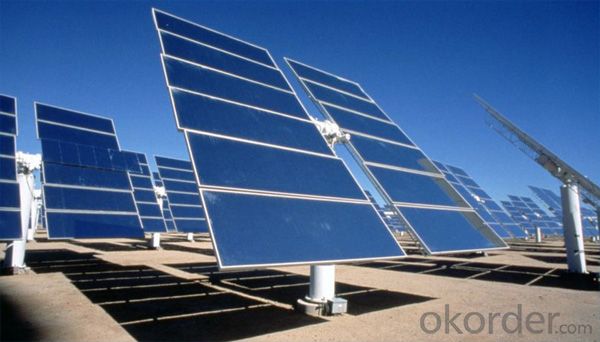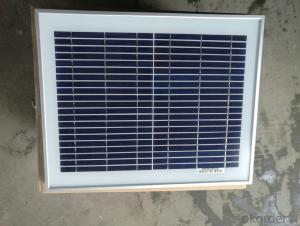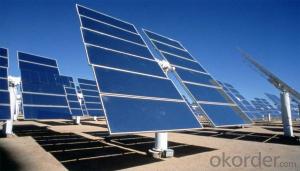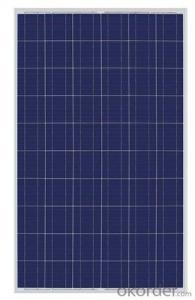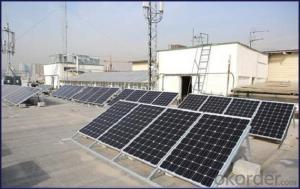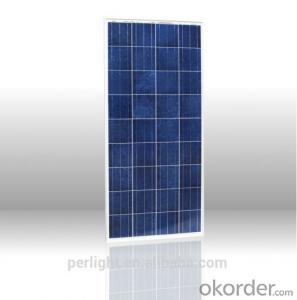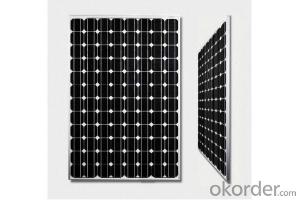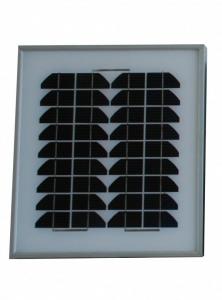CE and TUV Approved 10W Poly Solar Panel - Solar Panels Canberra
- Loading Port:
- Shanghai
- Payment Terms:
- TT OR LC
- Min Order Qty:
- 10000 watt
- Supply Capability:
- 20000000 watt/month
OKorder Service Pledge
OKorder Financial Service
You Might Also Like
Specification
1. The Introduction of Solar Module
Solar modules use light energy from the sun to generate electricity through the photovoltaic effect. The majority of modules use wafer-based crystalline silicon cells or thin-film cells based on cadmium telluride or silicon. The structural (load carrying) member of a module can either be the top layer or the back layer. Cells must also be protected from mechanical damage and moisture. Most solar modules are rigid, but semi-flexible ones are available, based on thin-film cells.
2.Technical Parameter
Type | CNBM Solar Polycrystalline Series |
Materials | Silicon |
Guarantee | 12 yrs free from defects in materials and workmanship No less than 90% within 10yrs and no less than 80% within 25yrs TUV(IEC61215&IEC61730), CE, UL |
Application | Photovoltaic/ solar/ green energy/ energy saving |
Descriptions | 1.High efficiency crystalline silicon solar cell. Even if under the weak light, the solar module can produce maximum power output. 2.Tempered glass (toughened glass): Anti-reflecting coating and high transmission rate glass increase the power output and mechanical strength of solar module. 3. EVA and TPT: Using high quality EVA and TPT to prevent destroying and water. 4. AI frame: Without screw, rner connection. 6 holes on the frame can be installed easily. 5. Junction box: Multi function junction box with water proof. 6. Long lifetime: ≥25 years; Less power decrease. 7. Good performance of preventing from atrocious weather such as wind and hails. 8. Resisting moisture and etching effectively, not effected by geology. 9. The certificate issued by international authority: UL, TUV, IEC, CE.
|
Packaging Details: | 26pcs/pallet, 28pallets/ 40HQ Our solar panels are packed in cartons, and then pallet. Shipping by sea or by air are both ok, it up to customer’s chose. We’d like to inquiry the freight cost for customer after be informed exact quantity and destination address. |
3. Application and Pictures of Products
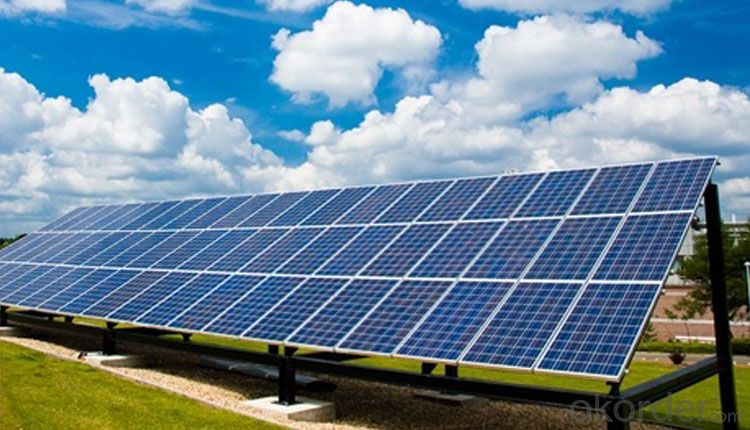
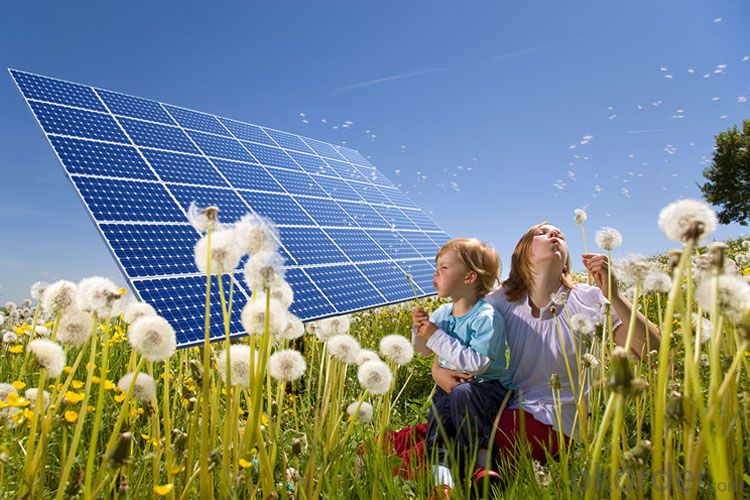
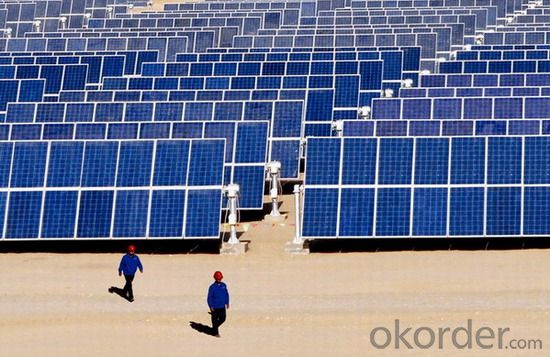
4. How to Work
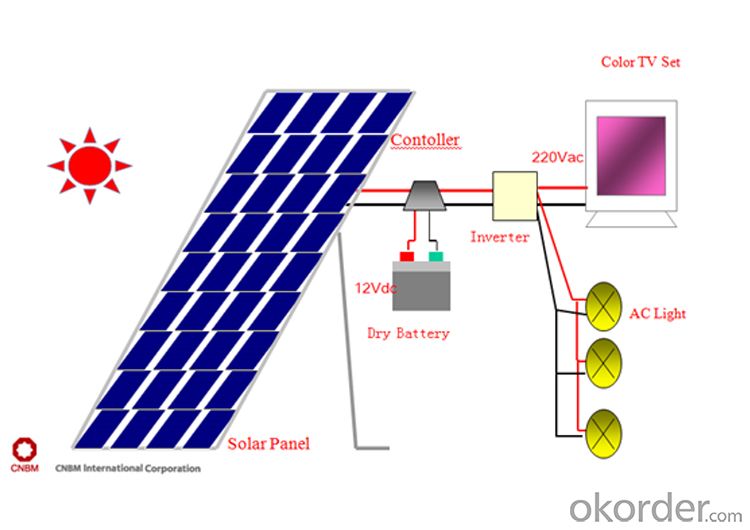
5. Packing Details
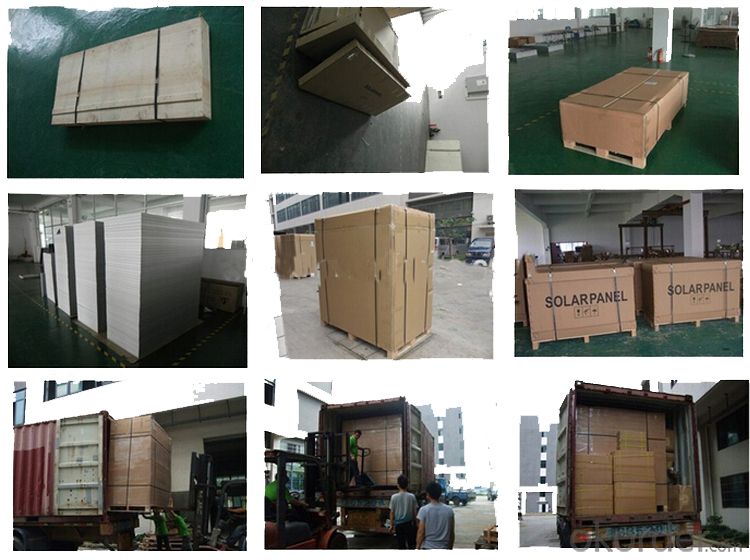
6. FAQ
Q1: What is the business type for the company?
A1: We are one of the biggest manufacturers in zhejiang.Chnia. Which is a high tech PV enterprise dedicated to the research, development, production and sales..
Q2: How long solar panel warranty can you offer?
A2: 10-Year product warranty,25-year linear power output warranty
If there is any quality problem, we will pay for freight and send free parts to you.
Q3: How many certificates do you have?
A3: We have 16 certificates,such as CE, TUV, UL, and so on.
- Q: solar panel capacity, how do it work
- Calculating Your Solar Power Requirements There are three main things to consider in order to choose a Solar panel or create a Solar system. : How much energy can your battery store? 2 : How much energy will your appliance(s) use over a period of time? 3 : How much energy can a Solar panel generate over a period of time?
- Q: Can solar panels be installed on data centers?
- Yes, solar panels can be installed on data centers. In fact, many data centers are increasingly adopting solar energy solutions to reduce their carbon footprint and dependence on non-renewable energy sources. Installing solar panels on data centers helps generate clean and sustainable electricity, thereby promoting environmental sustainability and cost savings in the long run.
- Q: How can solar panels be integrated into building designs?
- Solar panels can be integrated into building designs in various ways, such as through rooftop installations, building-integrated photovoltaics (BIPV), solar facades, and solar windows. By incorporating solar panels into the design, buildings can generate renewable energy while minimizing the visual impact and maximizing energy efficiency.
- Q: The average solar panel produces 0% of the energy that is put into it. What is happening to the other 90%? Is it being reflected or is it being obsorbed by materials that are not a part of the solar cell? Is it possible to one day have near 00% efficient solar cell technology?
- Mainly due to reflection (micro-structuring of the surface helps here), incorrect wavelength of the light (the panel is only sensitive to a certain wavelength range) and heating of the panel (due to the incident light/thermal radiation). The remainder is either reflected or absorbed by the cell and re-emitted as heat. Absorption by e.g. the glass panel is slight (a few %), as is absorption/reflection by the necessary surface contacts (again, a few %). Higher efficiency is possible, but brings its own drawbacks (like higher cost). You could now go into two directions: - high efficiency cells/panels with (likely) higher cost and complexity for mounting (like lens or mirror based systems, aka concentrator systems, that increase the light level on the cells in order to increase efficiency) - low cost systems (cheap as dirt) that will allow you to cover every surface of a building, efficiency is less important if you can compensate by a much larger covered area As to the efficiency limit: there is a theoretical limit (from thermodynamics - don't ask me how or why) in the range of 30...40%, depending on which publication you want to believe in.
- Q: Can solar panels be installed on factories or industrial buildings?
- Yes, solar panels can definitely be installed on factories or industrial buildings. In fact, these large structures often have expansive rooftops that can accommodate a considerable number of solar panels. Installing solar panels on factories or industrial buildings not only helps reduce their reliance on traditional energy sources, but also provides an opportunity for these establishments to generate their own sustainable and clean electricity.
- Q: Can solar panels be used for powering public transportation?
- Yes, solar panels can be used for powering public transportation. Solar energy can be harnessed through solar panels and converted into electricity, which can then be used to power electric buses, trains, trams, and other forms of public transportation. This helps reduce dependence on fossil fuels, lower greenhouse gas emissions, and promote sustainable and clean energy solutions for transportation systems.
- Q: How do solar panels affect the resale value of a home?
- Solar panels can have a positive impact on the resale value of a home. Studies have shown that properties with solar panels tend to sell faster and at a higher price compared to homes without them. Potential buyers view solar panels as a valuable and eco-friendly feature, leading to increased buyer interest and willingness to pay a premium for a home equipped with solar power.
- Q: i have a 2v 2a solar panel that i want to use to charge a 2v battery .Have found out that i need a charge controller so i don't over charge the battery.I have found a cheep one its 2v but 7a will it still work ?All-so im planing on running a 2v water pump off the battery with a timer,its for watering my garden.Will the timer have to be 2v as well ?any help on this would be greatly appreciated thanks .
- The charger will accept whatever current is necessary from the solar panel up to 7A. It's not like the solar panel will force 2amps into the charger/battery -- the charger will control the current going to the battery. I question whether or not the 2V panel will actually charge the battery, though, because in order to charge a standard lead-acid 2V battery you need to have about 4.5 volts applied to the terminals. Perhaps the charger has a boost circuit -- I don't know without looking at it or knowing the brand/model number, etc. The timer must be 2VDC, but, if you only have a timer that is rated for 20VAC, you can buy a small inverter that will take 2V and supply the necessary 20VAC. An inverter rated for 20 to 50 Watts should be sufficient. These usually cost under US$25. .
- Q: i need to make a mini-solar car which shouldn't cost much. it's for my science project. for now, i just found out how to make a solar panel using copper oxide, but it does not generate enough power to power up the engine of the toy car [ the small engine they used in the toys, like from TAMIA]
- I do not have the skills to make my own solalr panles even if I want to try it. I see the answer above but cannot understand it. I bought my solar panels from OKorder and it works for me quite well.
- Q: How much Electricity does a standard Solar panel producein terms of Watts and in terms of Units( i.e. electricity meter attached in our House)If I have 20 Solar panels and an inverter , how much electricity will I Be able to harness and store (state that in terms of volts)Can I run Arefridgerator, Iron, Heaters, Plasma T.V. and other high Electricity Consuming Devices.
- Take a look on OKorder at some of the books on how to design solar energy systems. It is a bit more complicated than you might expect. I'm not sure what you consider to be a standard solar panel, but the 3' ones I have produce about 5 watts of power in full sunlight. Put simply, you need to convert the power from the solar cells (variable voltage) into a constant voltage usable for charging a batteries. Most of the low cost modules for this purpose can't handle more than about 00 watts. Larger systems are available that handle thousands of watts but they are quite pricey. Since you can't take out more than you put into your battery system, you can calculate about how long you can run a high-current appliance based upon its wattage rating, that of the battery system (adjusted for loss of converting to AC), and the charging system.
Send your message to us
CE and TUV Approved 10W Poly Solar Panel - Solar Panels Canberra
- Loading Port:
- Shanghai
- Payment Terms:
- TT OR LC
- Min Order Qty:
- 10000 watt
- Supply Capability:
- 20000000 watt/month
OKorder Service Pledge
OKorder Financial Service
Similar products
Hot products
Hot Searches


